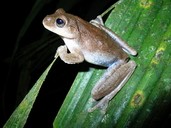Panama cross-banded tree frog
A species of Mexican burrowing tree frog Scientific name : Smilisca sila Genus : Mexican burrowing tree frog
Panama cross-banded tree frog, A species of Mexican burrowing tree frog
Scientific name: Smilisca sila
Genus: Mexican burrowing tree frog
Content
Description General Info
 Photo By John Kast , used under CC-BY-SA-2.5 /Cropped and compressed from original
Photo By John Kast , used under CC-BY-SA-2.5 /Cropped and compressed from original Description
Males grow to 45 mm (1.8 in) and females to 62 mm (2.4 in) in snout–vent length. They are gray, tan or reddish brown in dorsal colouration, with tuberculate skin. White or green flecks as well as darker blotches and markings may be present. Ventral surface is creamy white. 
General Info
Lifespan
5-8 years
Diet
Panama cross-banded tree frog's diet primarily comprises assorted forms of insects, especially caterpillars. This species also displays a preference for small invertebrates, which it usually hunts at night.
Appearance
Panama cross-banded tree frog is a small-sized frog with a slender body and smooth skin. It displays a bright green dorsal side, contrasting with its cream underparts. Notable are the dark stripes running from the snout to the groin, along with orange inner thighs. Adult males have larger vocal sacs than females. The frog, however, lacks any tails, wings, or horns.
Behavior
Panama cross-banded tree frog displays a nocturnal lifestyle, with its activities primarily revolving around foraging for food at night. This species remains solitary for most of the year, only gathering during breeding season. Notably, the males produce anomalously loud calls to attract mates. Panama cross-banded tree frog also practices adaptive anti-predatory behavior of playing dead when threatened.
Population
Stable
Scientific Classification
Phylum
Chordates Class
Amphibians Order
Frogs and toads Family
Tree frogs and their allies Species
Panama cross-banded tree frog